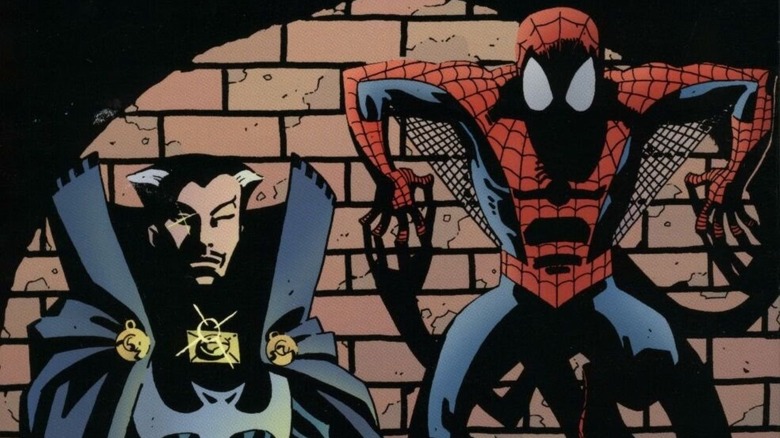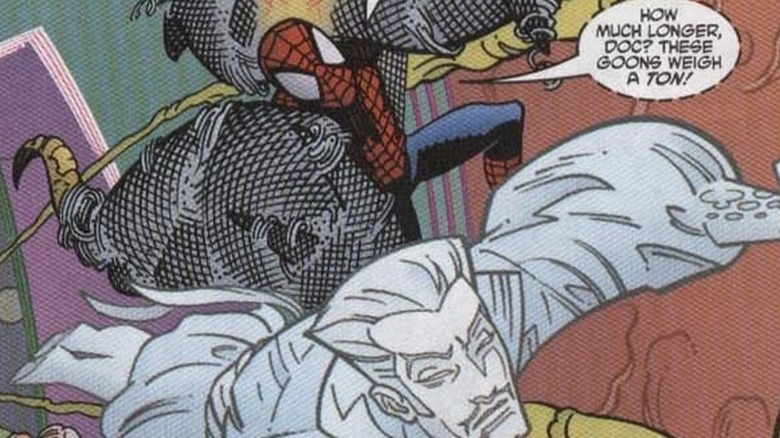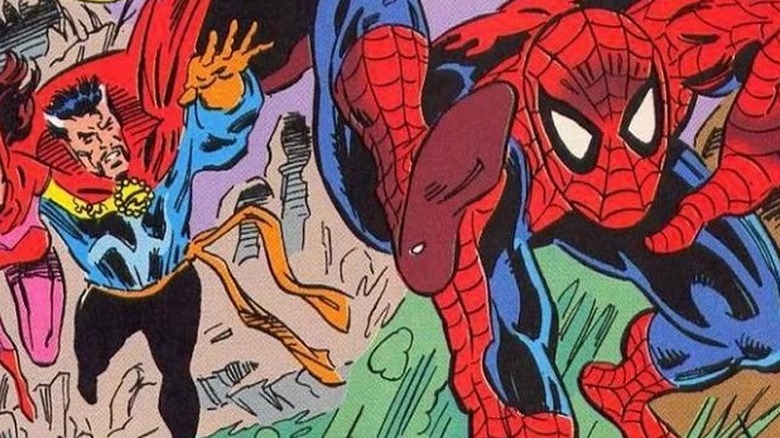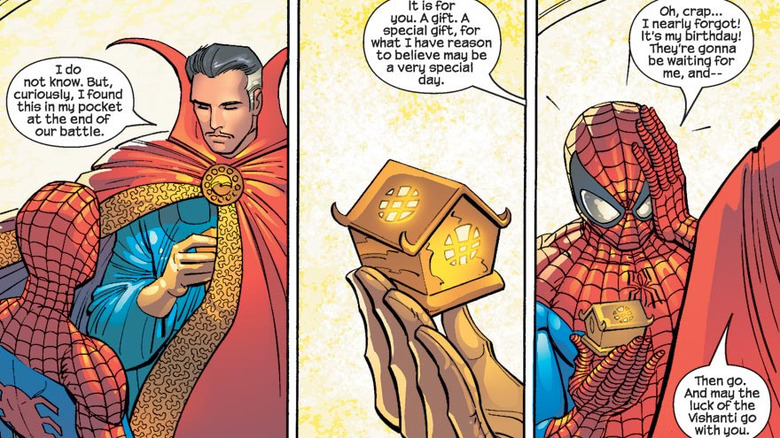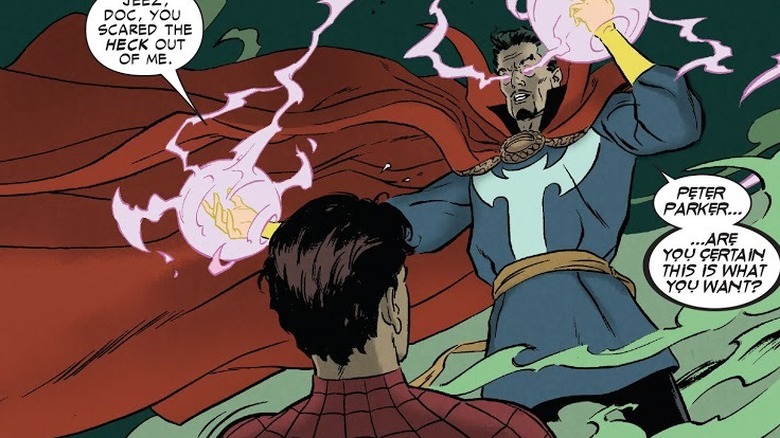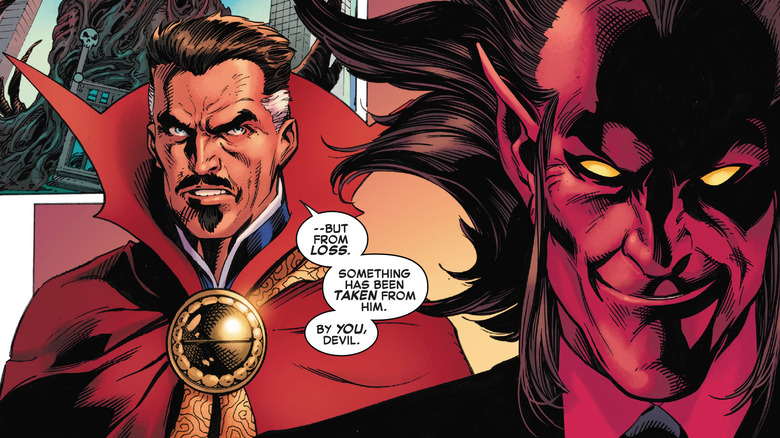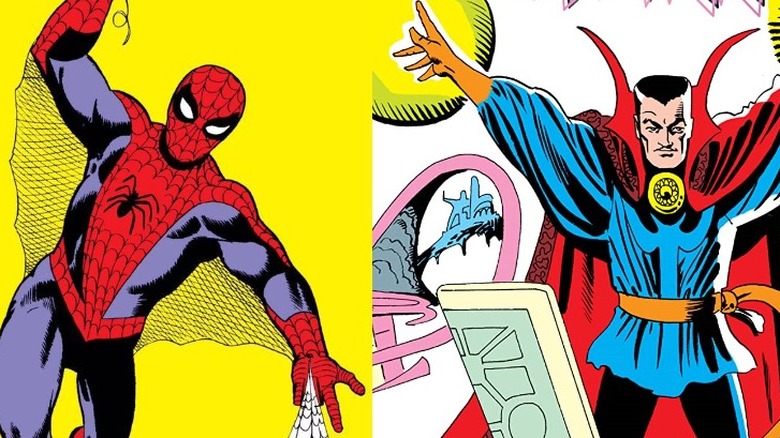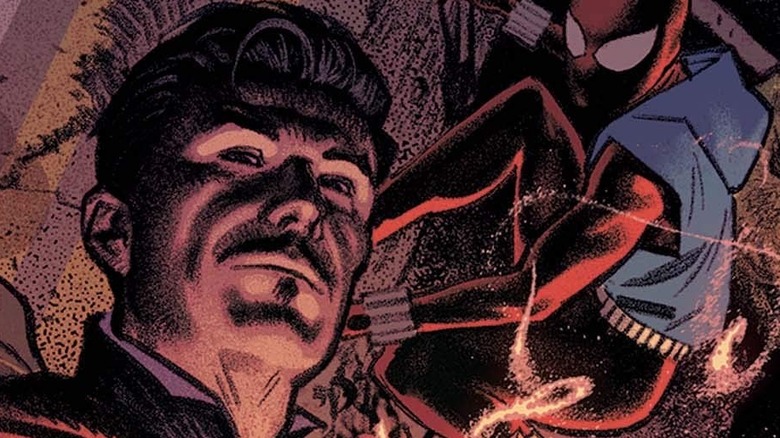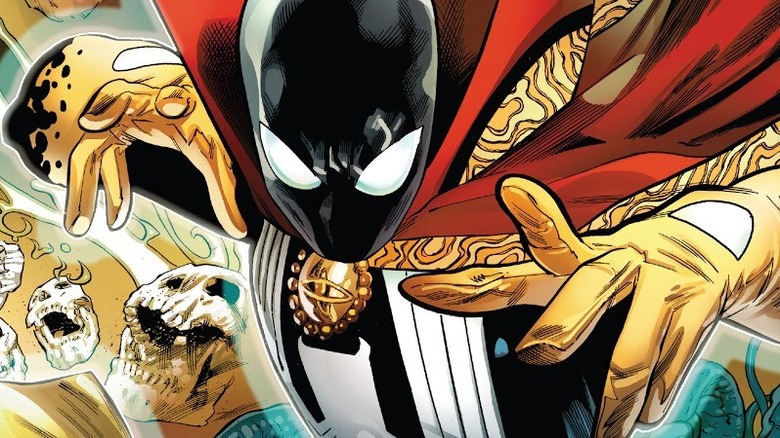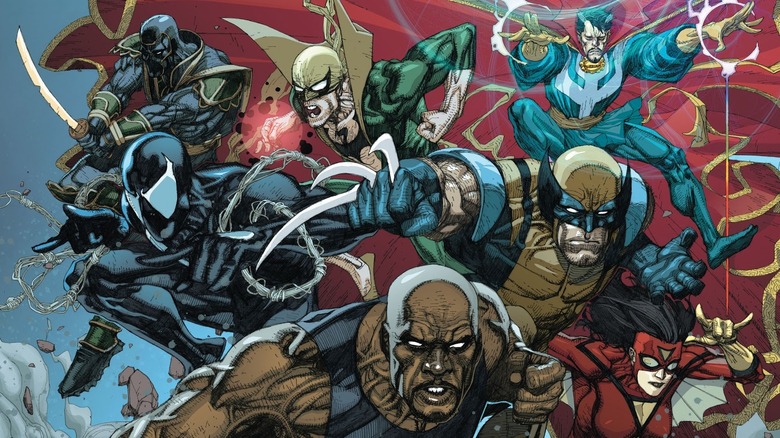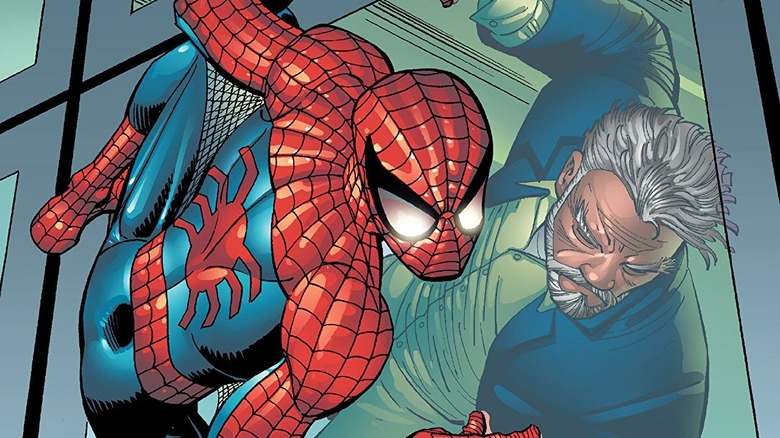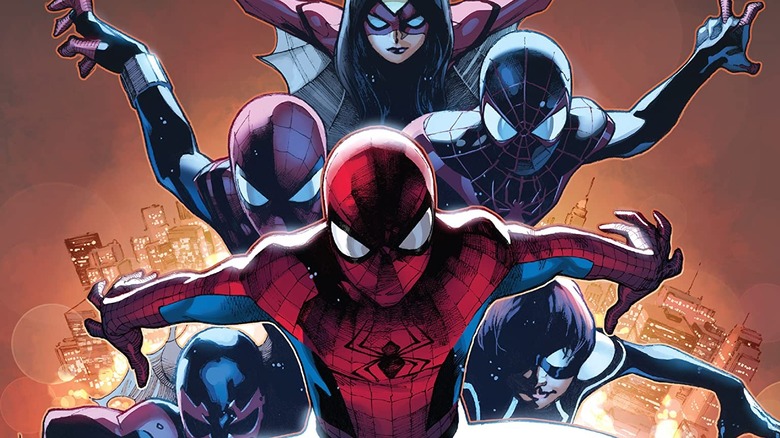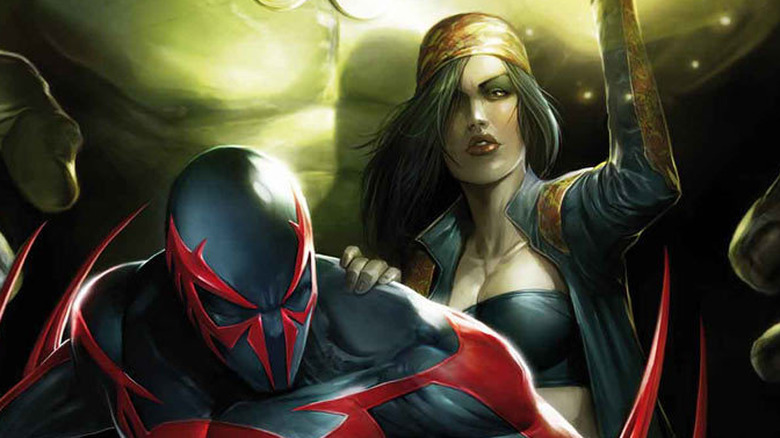The Untold Truth Of Spider-Man And Doctor Strange's Relationship
At their core, Peter Benjamin Parker and Stephen Vincent Strange are quite similar: Two brilliant but self-centered men of science who, after losing the parts of their lives that they valued most, dedicated their existence (and incredible abilities) to defending the weak and powerless against terrifying threats.
However, these New York-based Marvel heroes have wildly different circumstances and superpowers, and deal with villains that are on entirely different levels. The amazing Spider-Man prides himself on being everyone's friendly neighborhood superhero, and regularly pits his sensational spider-powers against street-level threats ranging from mutated scientists to muscle-bound crooks. Doctor Strange, on the other hand, is Earth's Sorcerer Supreme, a self-proclaimed Master of the Mystic Arts who defends humanity 24/7 from unimaginable, otherworldly horrors.
Still, despite their differences, Spider-Man and Doctor Strange are like chocolate and peanut butter: two great tastes that go well together. Perhaps that's why they've had quite a few comic book capers over the years, showcasing the spectacular synergy between these two oddball adventurers. Here is the untold truth of Spider-Man and Doctor Strange's relationship throughout their publication history.
Spider-Man and Doctor Strange's first team-up: Literally out of this world
According to Comic Book Resources, the first time Spider-Man and Doctor Strange were shown working together on the printed page was in 1965's "Amazing Spider-Man Annual" #2. (The good doctor actually appeared in three panels in the previous annual, but only in his astral form.) This marvelous team-up featured the webslinger and the Sorcerer Supreme pitting their wits and powers against a sinister magic-user named Xandu, who sought to steal a powerful artifact from Strange's stronghold called the Sanctum Sanctorum. After foiling the villain's plans in an interdimensional battle, Strange pledges his allegiance to the hero, planting the seed that would literally and figuratively grow into a magical friendship.
Chronologically, however, Spider-Man and Strange's first adventure together may have been in 1998's "Untold Tales of Spider-Man: Strange Encounters." In this flashback story, Strange enlists the wall-crawler's assistance in recovering the mystical Lantern of Lantarr, which some thugs stole from a museum. Due to an earlier encounter with the lantern-wielding crooks, Spider-Man's senses become attuned to the ancient object's location. The trail leads to one of Strange's most dangerous foes, Baron Mordo, who plans to offer human sacrifices to his patron Enigma in exchange for ultimate power. In the end, the two defeat Mordo; Strange erases the memories of Mordo's captives at Spider-Man's request, even though it meant they'd forget the latter's heroic acts. This makes Strange realize that there's more to this young man than meets the eye.
Spider-Man was one of Doctor Strange's Secret Defenders
Out of all the tricks hidden in Doctor Strange's billowy sleeves, his hero-summoning tarot cards are perhaps the most interesting, purely from a crossover perspective. When faced with incredible threats that he can't handle alone, he uses the cards to assemble an impromptu team called the Secret Defenders. The roster changes depending on who the cards reveal; more often than not, the selected players are the heroes (or anti-heroes) who are best equipped to deal with the menace at hand.
In issues #6 to #8 of the first volume of "Secret Defenders," Strange enlists the aid of Spider-Man and the Scarlet Witch to stop his persistent foe Xandu (the same magic-user Strange and Spider-Man fought in some of their early adventures) from enacting his mad plan: to merge Earth with the Death Dimension and form a new reality under his rule. The cards initially pick Ghost Rider as the fourth member of the roster, but Strange is unable to contact him. Instead, Captain America joins the patchwork team, after accidentally stumbling upon some magical chaos during his nightly patrol.
With the aid of the magical Wand of Watoomb, Xandu nearly succeeds in his plot. However, thanks to a last-minute strategy that Strange and Captain America pull off, Xandu's former lover Melinda becomes the queen of the Death Dimension. Feeling disgust over Xandu's actions, she casts him out of the Death Dimension permanently, ending his brief but tumultuous reign.
Doctor Strange gave Spider-Man the best birthday present ever
Spider-Man's used to facing all kinds of danger, but even he acknowledges that magical menaces are a bit above his pay grade. Thus, whenever these mystical threats pop up in his corner of the superhero world, he's more than happy to receive assistance from the Sorcerer Supreme.
One of the most noteworthy instances of this was in the three-part story "Happy Birthday," which ran from "Amazing Spider-Man" vol. 2 #57 (technically vol. 1 #498) to the officially renumbered "Amazing Spider-Man" vol. 1 #500. After being soundly defeated and scattered across dimensions by Strange, the evil being Dormammu tricks New York's heroes into helping him reconstitute himself. As swarms of his Mindless Ones overrun Manhattan, a mystical mishap knocks Spider-Man and Doctor Strange outside of time and space. They attempt to return to Earth, but end up at two different points in time, billions of years apart. With a spell, Strange takes Spider-Man through his whole past — including reliving every battle he ever fought — up to the exact moment where all hell broke loose. Spider-Man successfully prevents the heroes from releasing Dormammu, with only the sorcerer and the spider having any recollection of what transpired.
As a reward (and birthday present), Strange hands Spider-Man a tiny golden chest. When he opens it, he receives the best surprise of his life: A few minutes with his Uncle Ben, who tells him just how proud he is of the man Peter has become.
Doctor Strange made the world forget Spider-Man's secret identity
During Marvel's "Civil War" event, Spider-Man does the unthinkable: In support of the Superhuman Registration Act pioneered by his new mentor Tony Stark, he publicly unmasks and tells the world that he is Peter Parker. Unsurprisingly, this decision proves to be a huge mistake, as his Aunt May is hit by a bullet courtesy of one of the Kingpin's assassins. As the life of his longtime mother figure hangs in the balance, Peter seeks the aid of Doctor Strange to save her in "Friendly Neighborhood Spider-Man" vol. 1 #24.
Unfortunately, the mystical master admits he can do nothing to save her life. He helps Peter reach out to the Marvel universe's geniuses, but they all give him the same answer. In his desperation, Peter Parker strikes a literal deal with the devil Mephisto to save his dying aunt. In return, the demonic ruler asks for Peter's marriage with Mary Jane Watson, which he deems as the rarest, purest love of all. (This forms the core of the infamous "One More Day" storyline, which many Spider-Man fans regard as one of the worst stories in the wall-crawler's history.)
To hold up his end of the deal, Mephisto rewrites history so that the marriage never happened. "Amazing Spider-Man" vol. 1 #641 reveals that In this new reality, Doctor Strange, Mister Fantastic, and Iron Man merge science and magic to make the world forget Spider-Man's secret identity.
Doctor Strange knows about Spider-Man's deal with Mephisto
In the concluding chapter of "One Moment in Time," Iron Man's Extremis technology infects the world with a virus-infused spell made by Doctor Strange and Mister Fantastic. This makes everyone (except for Peter Parker and Mary Jane Watson) forget Spider-Man's secret identity. All of these are due to the machinations of Mephisto, as part of a deal to save Spider-Man's aunt from death; no one, not even Peter himself, remembers the demon's involvement in this. Regardless, this ushers in a "Brand New Day" for the webslinger, a clean slate of sorts that would remain largely intact for over a decade in real time.
That is, until the events of "Amazing Spider-Man" vol. 5 #51 came to pass. In order to free his spider-powered allies from the thrall of a literal villain-from-Hell called Kindred, Spider-Man consults Strange, who attempts to cast a spell with a mystical item to help him. Surprisingly, the spell fails, prompting Strange to wonder if the wall-crawler has ever unknowingly struck any mystical deals in the past.
Strange's suspicions lead him to the door of the Hotel Inferno in Las Vegas, Mephisto's earthly base of operations. There, he asks Mephisto point-blank to tell him what's wrong with Peter Parker's soul. Their game continues soon after, however, and Strange eventually manages to put a stop to Mephisto's plans and free Spider-Man from the demon's control. Only then is it revealed why Mephisto targeted Peter and MJ's relationship in the first place: because he fears the power of their potential child.
Spider-Man and Doctor Strange: Steve Ditko's greatest Marvel creations
The late artist Steve Ditko was one of the early architects of the Marvel universe, illustrating many memorable stories and co-creating two of the company's most popular heroes. Ditko drew Spider-Man's very first adventure in 1962's "Amazing Fantasy" vol. 1 #15; he also illustrated the debut of Doctor Strange in the pages of "Strange Tales" vol. 1 #110, published a year later.
Observant comic book readers have noticed that Spider-Man and Strange make the same hand gesture (thumb, pointing finger, and pinky finger straight out, with the middle and ring fingers folded in) whenever they execute their signature moves. The two characters themselves humorously take note of this at the end of the 2010 limited series "Spider-Man: Fever." Whether it's a deliberate choice by Ditko or simply a coincidence was never officially addressed by the artist, who infamously hated talking about his past works.
In an article for Vulture, Abraham Riesman talks about his experience in attempting to contact Ditko, whose last interview with a journalist took place in 1968. After their six-and-a-half-second interaction — the Marvel legend flat-out refused to talk to Riesman — the writer was able to sum up his thoughts on the creator, relating them to how Stan Lee described the first Strange story as Ditko's brainchild: "Ditko expanded the visual, narrative, and even philosophical potential of comics in a way that few others have. 'Twas Steve's idea. Maybe that's all we need to know."
Doctor Strange has worked with Spider-Man's doppelgangers
Spider-Man and Doctor Strange have worked together on multiple occasions, showcasing their best (and worst) qualities to each other in the process. Interestingly, the good doctor has also had the opportunity to collaborate with two of the webslinger's most prominent copycats, both of whom were products of science gone right (or wrong).
In the 2017 limited series "Damnation," Strange's longtime ally Wong assembles a temporary team of supernatural heroes (Blade, Doctor Voodoo, Elsa Bloodstone, Iron Fist, Ghost Rider, Man-Thing, and Moon Knight) to save Las Vegas from being overtaken by Mephisto's minions. In the nick of time, the team is saved from certain doom by the Scarlet Spider, a.k.a. Peter Parker's clone Ben Reilly. Together, they are able to find Doctor Strange and restore Las Vegas to its normal state.
The Sorceror Supreme has also allied himself with another superlative-using superhero: the Superior Spider-Man, a reformed Doctor Octopus occupying a "perfect clone" body of Peter Parker. In 2019's "Superior Spider-Man" vol. 2 #5, the Eye of Agamotto reveals the true identity of the San Francisco-based vigilante to Strange, after the former summons the latter for assistance in defeating magical threats to his city. Initially apprehensive to work with a notorious criminal, Strange and Superior Spider-Man set aside their differences and save the day. Their shared adventure ends with Strange giving some well-meaning advice to the arrogant hero about honesty and accountability.
Doctor Strange mentored Spider-Man in the ways of the Mystic Arts
During Spider-Man's brief but memorable time with his black costume — an alien symbiote that would later form half of the popular antihero Venom — Peter Parker went on quite a few adventures, some of which he barely remembers himself. One of these untold chapters of his life was brought to light in the 2020 limited series "Symbiote Spider-Man: Alien Reality," which also revealed that at one point, he actually received training in the Mystic Arts from Doctor Strange himself.
Waking up to a bizarre world he barely recognizes, a symbiote-clad Spider-Man rushes to the Sanctum Sanctorum, in an attempt to get some clarity from Strange. What he finds there shocks him: The Hobgoblin, his longtime foe, has become the apprentice of a different Sorcerer Supreme, and Strange himself is nowhere to be found.
Eventually, the paths of the spider and the sorcerer cross; Strange explains how the world was transformed by a powerful book called the Word of God. Together, they concoct a plan to set the world right again, which includes teaching Spider-Man a few defensive spells to give him a fighting chance against his newly mystic-powered foe. Strange and Spider-Man manage to defeat Hobgoblin and his master, Baron Mordo, with some assistance from the otherworldly being called Nightmare. However, Spider-Man retains no memory of the events that transpired — including all the spells he learned under Strange, sadly.
Doctor Strange and Spider-Man were on the same Avengers roster
In his early years, Spider-Man made a number of attempts to join the Avengers, with varying levels of success. Prior to 2005, the closest he had gotten to becoming a card-carrying Avengers was becoming a reserve member in 1991's "Avengers" vol. 1 #329. That changed, however, when he joined the New Avengers as a full-time member alongside Captain America, Iron Man, Spider-Woman, Luke Cage, Wolverine, and the Sentry, following an attempted escape by the inmates at the supervillain prison called the Raft. And in the next massive Avengers membership shake-up, Spider-Man found himself joining hands with his longtime magical ally (and fellow Avengers newbie), Doctor Strange.
"New Avengers" vol. 1 #27 features the debut of the renegade Avengers team (made up of Spider-Man, Strange, Cage, Iron Fist, Wolverine, Spider-Woman, and Ronin) as they rescue their newest recruit, Maya Lopez a.k.a. Echo, from Elektra and The Hand. Driven underground after the events of the superhuman Civil War, this team of "NEW new Avengers" (as Spider-Man himself described) operates from Strange's Sanctum Sanctorum, while evading arrest at the hands of the government-sanctioned team of Avengers led by Iron Man.
Are Spider-Man's powers mystical in origin?
For a superhero who is strictly grounded in science, Spider-Man does tend to find himself tangled up in magical situations far more than expected. And while he normally has his ally Doctor Strange to back him up in such situations, there have been occasions in which the webslinger found himself wondering about the true nature of his spider-powers — and if he was actually more connected to the mystical realm than he'd initially thought.
In "Amazing Spider-Man" vol. 2 #30, Spider-Man crosses paths with the enigmatic Ezekiel, an old man who also possesses spider-powers. Shockingly, Ezekiel also knows Spider-Man's secret identity, casually dropping it on the hero along with another bomb: "Did the radiation enable the spider [that bit you] to give you those powers? Or was the spider trying to give you those powers before the radiation killed it?" In subsequent issues, Spider-Man finds himself facing an assortment of mystical foes, including the dimension-hopping psychic vampire Morlun, the astral ghost-like Shade (whom Spider-Man beats with Strange's help), and the astral spider-wasp Shathra.
Spider-Man can traverse the Multiverse without Doctor Strange's help
Whenever Spider-Man and Doctor Strange team up, it's almost a given that their adventures would involve some form of interdimensional travel. In the '60s, such stories were an opportunity for Steve Ditko to showcase his talent for drawing mind-boggling, otherworldly backdrops. In modern times, however, Spider-Man has found himself unassisted by the Sorcerer Supreme while crossing the boundaries of the Marvel multiverse — or to be more specific, the Spider-Verse.
While the concept of a room full of Spider-Men teaming up was introduced in 1994's "Spider-Man: The Animated Series," the first time that comic books would adapt the idea on a comparable scale was in the 2014 multi-part crossover called "Spider-Verse." The story features the main Spider-Man, Peter Parker of Earth-616, reaching out to various Spider-people across time and space and enlisting their aid in a no-holds-barred battle against the psychic vampire Morlun and the rest of his cursed family, the Inheritors.
The Spiders are able to travel from one dimension to the next via the Web of Life and Destiny, a multiversal passageway anchored on Earth-001 created by the extra-dimensional "Spider-God," Kwaku Anansi. They are able to harness this unique ability through special wrist communicators.
The 2099 versions of Spider-Man and Strange are tight allies, too
The cooperative relationship between Spider-Man and Doctor Strange would be reflected in the dystopian world of 2099 by their future counterparts. In fact, the timely interference of one ends up saving the other from predestined death.
The Spider-Man of 2099, Miguel O'Hara, is a gifted but arrogant geneticist who begins his heroic journey after a sabotaged lab experiment grants him spider-powers. Meanwhile, the self-proclaimed Sorceress Supreme of this bleak, corporation-controlled future is a young woman named Jeannie who trained herself in the Mystic Arts. When Spider-Man 2099 and Strange 2099 first meet in the pages of "Spider-Man 2099" vol. 1 #32, the sorceress asks for the aid of the "S-Man" in putting a stop to a zombie invasion in Mexico City.
After this adventure, the two heroes would find themselves teaming up from time to time, fighting against such foes as the Maestro, the murderous future version of the Hulk. However, the most crucial piece of assistance that Spider-Man 2099 ever receives from the Sorceress Supreme happens in the final issue of vol. 3 of his eponymous comic book. Sustaining near-fatal injuries in a present-day battle against his mutated, hypnotized lover Tempest, Miguel is saved from certain death by a last-minute spell cast by Strange 2099. By the time Spider-Man 2099 wakes up, his injuries have been healed, and he has been transported to Strange's headquarters in the year 2100 (to prevent his survival from messing up the timeline).
